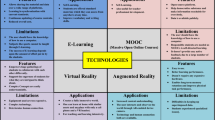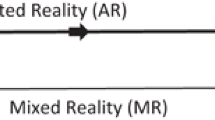Abstract
The Augmented Reality (AR) technology provides unique affordances for education that are only yet started to be explored. In this work the benefits and potential uses of AR technology for supporting communication in presentations are explored. An Augmented Presentation Feedback System (APFs) is presented, which allows a speaker equipped with a pair of Augmented Reality goggles to visualize visual cues depicted over the listeners’ heads. These can be used as a way to provide the speaker with feedback on his/her explanations. The results of a case study conducted showed that the system not only assists the speaker in adapting the content and pace of the explanation to the listener, but also helps to better manage their interventions and improve the flow of the presentation.
Access this chapter
Tax calculation will be finalised at checkout
Purchases are for personal use only
Preview
Unable to display preview. Download preview PDF.
Similar content being viewed by others
References
Chen, G.D., Chao, P.Y.: Augmenting Traditional Books with Context-Aware Learning Supports from Online Learning Communities. Educational Technology & Society 11, 27–40 (2008)
Priestnall, G., Brown, E., Sharpless, M., Polmear, G.: A Student-Led Comparison of Techniques for Augmenting the Field Experience (2009)
Zarraonandia, T., Aedo, I., Díaz, P., Montero, A.: An Augmented Lecture Feedback System to Support Learner and Teacher Communication. Journal of British Educational Technology 44(4) (July 2013)
Caldwell, J.E.: Clickers in the Large Classroom: Current Research and Best-Practice Tips. CBE-Life Sciences Education 6 (2007)
Yin, R.K.: Case Study Research: Design and Methods, vol. 5. Sage Publications, Incorporated (2008)
Hevner, A.R., March, S.T., Park, J., Ram, S.: Design Science in Information Systems Research. MIS Quarterly 28, 75–105 (2004)
Lazer, J., Fenq, J.H., Hochheiser, H.: Research Methods in Human-Computer Interaction. Wiley (2010)
Glaser, B.G., Strauss, A.L.: The Discovery of Grounded Theory: Strategies for Qualitative Research. Aldine de Gruyter (1967)
Author information
Authors and Affiliations
Editor information
Editors and Affiliations
Rights and permissions
Copyright information
© 2013 Springer International Publishing Switzerland
About this paper
Cite this paper
Zarraonandia, T., Aedo, I., Díaz, P., Montero, A. (2013). A Case of Use of Augmented Reality for Supporting Communication in Presentations. In: Urzaiz, G., Ochoa, S.F., Bravo, J., Chen, L.L., Oliveira, J. (eds) Ubiquitous Computing and Ambient Intelligence. Context-Awareness and Context-Driven Interaction. Lecture Notes in Computer Science, vol 8276. Springer, Cham. https://doi.org/10.1007/978-3-319-03176-7_14
Download citation
DOI: https://doi.org/10.1007/978-3-319-03176-7_14
Publisher Name: Springer, Cham
Print ISBN: 978-3-319-03175-0
Online ISBN: 978-3-319-03176-7
eBook Packages: Computer ScienceComputer Science (R0)




